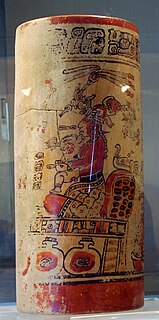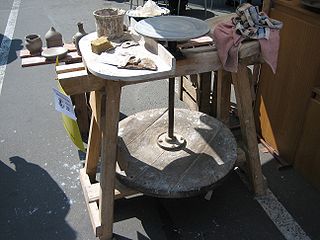
Pottery is the process and the products of forming vessels and other objects with clay and other ceramic materials, which are fired at high temperatures to give them a hard, durable form. Major types include earthenware, stoneware and porcelain. The place where such wares are made by a potter is also called a pottery. The definition of pottery used by the American Society for Testing and Materials (ASTM), is "all fired ceramic wares that contain clay when formed, except technical, structural, and refractory products." In archaeology, especially of ancient and prehistoric periods, "pottery" often means vessels only, and figures of the same material are called "terracottas." Clay as a part of the materials used is required by some definitions of pottery, but this is dubious.

Cookware and bakeware are types of food preparation containers, commonly found in a kitchen. Cookware comprises cooking vessels, such as saucepans and frying pans, intended for use on a stove or range cooktop. Bakeware comprises cooking vessels intended for use inside an oven. Some utensils are considered both cookware and bakeware.

Maya ceramics are ceramics produced in the Pre-Columbian Maya culture of Mesoamerica. The vessels used different colors, sizes, and had varied purposes. Vessels for the elite could be painted with very detailed scenes, while utilitarian vessels were undecorated or much simpler. Elite pottery, usually in the form of straight-sided beakers called "vases", used for drinking, was placed in burials, giving a number of survivals in good condition. Individual examples include the Princeton Vase and the Fenton Vase.

In pottery, a potter's wheel is a machine used in the shaping of round ceramic ware. The wheel may also be used during the process of trimming the excess body from dried ware, and for applying incised decoration or rings of colour. Use of the potter's wheel became widespread throughout the Old World but was unknown in the Pre-Columbian New World, where pottery was handmade by methods that included coiling and beating.
Ceramic forming techniques are ways of forming ceramics, which are used to make everything from tableware such as teapots to engineering ceramics such as computer parts. Pottery techniques include the potter's wheel, slipcasting, and many others.

Maria Montoya Martinez was a Native American artist who created internationally known pottery. Martinez, her husband Julian, and other family members examined traditional Pueblo pottery styles and techniques to create pieces which reflect the Pueblo people's legacy of fine artwork and crafts. The works of Maria Martinez, and especially her black ware pottery, survive in many museums, including the Smithsonian, the Metropolitan Museum of Art, the Denver Art Museum, and more. The Penn Museum in Philadelphia holds eight vessels – three plates and five jars – signed either "Marie" or "Marie & Julian". Maria Martinez was from the San Ildefonso Pueblo, a community located 20 miles northwest of Santa Fe, New Mexico. At an early age, she learned pottery skills from her aunt and recalls this "learning by seeing" starting at age eleven, as she watched her aunt, grandmother, and father's cousin work on their pottery during the 1890s. During this time, Spanish tinware and Anglo enamelware had become readily available in the Southwest, making the creation of traditional cooking and serving pots less necessary. Traditional pottery making techniques were being lost, but Martinez and her family experimented with different techniques and helped preserve the cultural art.

Bucchero is a class of ceramics produced in central Italy by the region's pre-Roman Etruscan population. This Italian word is derived from the Latin poculum, a drinking-vessel, perhaps through the Spanish búcaro, or the Portuguese púcaro.
This is a list of pottery and ceramic terms.
Stonesetting is the art of securely setting or attaching gemstones into jewelry.

A climbing hold is a shaped grip that is usually attached to a climbing wall so climbers can grab or step on it. On most walls, climbing holds are arranged in paths, called routes, by specially trained route setters. Climbing holds come in a large array of sizes and shapes to provide different levels of challenge to a climber. Climbing holds are either bolted to a wall via hex-head bolts and existing t-nuts or they are screwed on with several small screws. In extreme cases, concrete anchors may be used.

Coiling is a method of creating pottery. It has been used to shape clay into vessels for many thousands of years. It is found across the cultures of the world, including Africa, Greece, China, and Native American cultures of New Mexico. Using the coiling technique, it is possible to build thicker or taller walled vessels, which may not have been possible using earlier methods. The technique permits control of the walls as they are built up and allows building on top of the walls to make the vessel look bigger and bulge outward or narrow inward with less danger of collapsing. To do this, the potter takes a pliable material then rolls it until it forms a coil, or long pliable cylinder. By placing one coil on top of another, different shapes can be formed. As this is done while the clay is still fresh and soft, individual coils can be joined seamlessly with simple pressure, rather than by scoring and/or applying slip to the surface. Optionally, coils may only be joined internally or externally, leaving them visible on the other side as an aesthetic choice.

Onggi is Korean earthenware, which is extensively used as tableware, as well as storage containers in Korea. It includes both unglazed earthenware fired near 600 to 700°C and pottery with a dark brown glaze fired at over 1100°C.

Ceramics in Mexico date back thousands of years before the Pre-Columbian period, when ceramic arts and pottery crafts developed with the first advanced civilizations and cultures of Mesoamerica. With one exception, pre-Hispanic wares were not glazed, but rather burnished and painted with colored fine clay slips. The potter's wheel was unknown as well; pieces were shaped by molding, coiling and other methods.

Mississippian culture pottery is the ceramic tradition of the Mississippian culture found as artifacts in archaeological sites in the American Midwest and Southeast. It is often characterized by the adoption and use of riverine shell-tempering agents in the clay paste. Shell tempering is one of the hallmarks of Mississippian cultural practices. Analysis of local differences in materials, techniques, forms, and designs is a primary means for archaeologists to learn about the lifeways, religious practices, trade, and interaction among Mississippian peoples. The value of this pottery on the illegal antiquities market has led to extensive looting of sites.

Structural clay tile describes a category of burned-clay building materials used to construct roofing, walls, and flooring for structural and non-structural purposes, especially in fireproofing applications. Also called building tile, structural terra cotta, hollow tile, and clay block, the material is an extruded clay shape with substantial depth that allows it to be laid in the same manner as other clay or concrete masonry. In North America it was chiefly used during the late 19th and early 20th centuries, reaching peak popularity at the turn of the century and declining around the 1950s. Structural clay tile grew in popularity in the end of the nineteenth-century because it could be constructed faster, was lighter, and required simpler flat falsework than earlier brick vaulting construction. Each unit is generally made of clay or terra-cotta with hollow cavities, or cells, inside it. The material is commonly used in floor arches, fireproofing, partition walls, and furring. It continues to be used in Europe to build fire-resistant walls and partitions. In North America the material has largely been replaced by concrete masonry units.

Mata Ortiz pottery is a recreation of the Mogollon pottery found in and around the archeological site of Casas Grandes (Paquimé) in the Mexican state of Chihuahua. Named after the modern town of Mata Ortiz, which is near the archeological site, the style was propagated by Juan Quezada Celado. Quezada learned on his own to recreate this ancient pottery and then went on to update it. By the mid 1970s, Quezada was selling his pottery and teaching family and friends to make it and the pottery was able to penetrate the U.S. markets thanks to efforts by Spencer MacCallum and later Walt Parks along with Mexican traders. By the 1990s, the pottery was being shown in museums and other cultural institutions and sold in fine galleries. The success of the pottery, which is sold for its aesthetic rather than its utilitarian value, has brought the town of Mata Ortiz out of poverty, with most of its population earning income from the industry, directly or indirectly.

Ceramic art is art made from ceramic materials, including clay. It may take forms including artistic pottery, including tableware, tiles, figurines and other sculpture. As one of the plastic arts, ceramic art is one of the visual arts. While some ceramics are considered fine art, as pottery or sculpture, most are considered to be decorative, industrial or applied art objects. Ceramics may also be considered artefacts in archaeology. Ceramic art can be made by one person or by a group of people. In a pottery or ceramic factory, a group of people design, manufacture and decorate the art ware. Products from a pottery are sometimes referred to as "art pottery". In a one-person pottery studio, ceramists or potters produce studio pottery.

Philippine ceramics refers to ceramic art and pottery designed or produced as a form of Philippine art. The tradition of Philippine ceramics dates back to the third millennium BCE. Pottery and ceramics were an essential part of the trade between the Philippines and its neighbours. There are many local traditions of earthenware ceramics in the Philippines.

Ancient Egyptian pottery includes all objects of fired clay from ancient Egypt. First and foremost, ceramics served as household wares for the storage, preparation, transport, and consumption of food, drink, and raw materials. Such items include beer and wine mugs and water jugs, but also bread molds, fire pits, lamps, and stands for holding round vessels, which were all commonly used in the Egyptian household. Other types of pottery served ritual purposes. Ceramics are often found as grave goods.

Cord-marked pottery or Cordmarked pottery is an early form of a simple earthenware pottery made in precontact villages. It allowed food to be stored and cooked over fire. Cord-marked pottery varied slightly across the world, depending upon the clay and raw materials that were available. It generally coincided with cultures moving to an agrarian and more settled lifestyle, like that of the Woodland period, as compared to a strictly hunter-gatherer lifestyle.
















